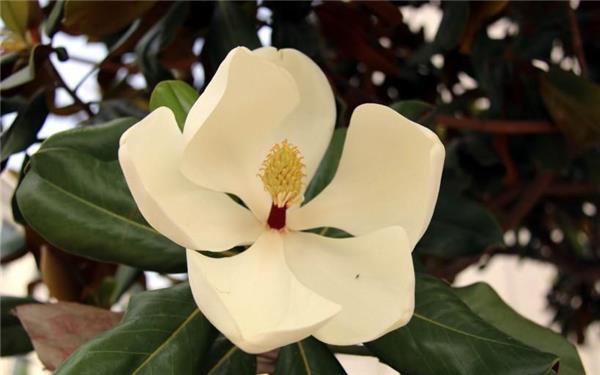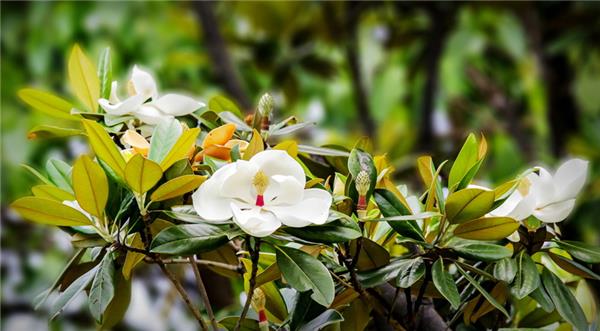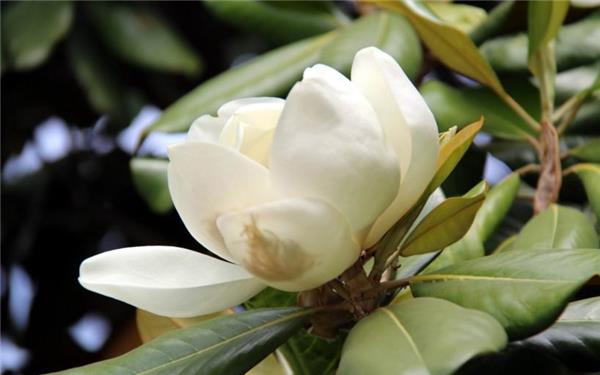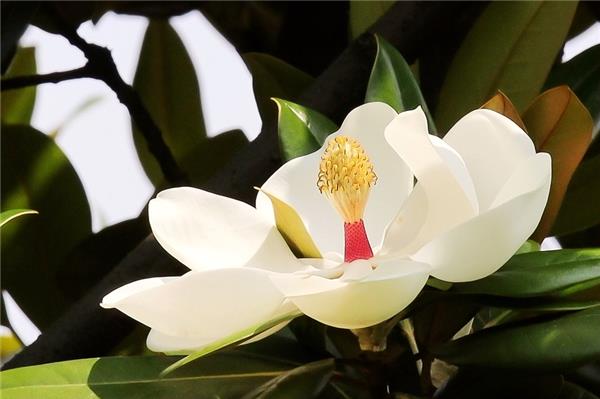Breeding methods and Culture points for attention of Magnolia lanceolata
Magnolia lanceolata is an evergreen tree with a strong life span of up to 30 years, which is relatively easy to breed. Let's take a look at it.

1. Morphological characteristics of Magnolia lanceolata
Evergreen trees, up to 30 m in origin; bark light brown or gray, thin scalelike dehiscence; branchlets stout, with transverse pith; under branchlets, buds, leaves, petiole, densely brown or grayish brown tomentose. Leaves thickly leathery, elliptic, oblong-elliptic or Obovate-elliptic, 10-20 cm long and 4-7 cm wide, apex obtuse or shortly obtuse, base cuneate, leaf surface dark green, glossy; lateral veins 8-10 on each side; petiole 1.5-4 cm long, without stipule scars, deeply furrowed. Lotus magnolia white, fragrant, 15-20 cm in diam.; tepals 9-12, thickly fleshy, Obovate, 6-10 cm long and 5-7 cm wide; stamens ca. 2 cm long, filaments flattened, purple, anthers introverted, connectives protruding into mucronate; pistil groups elliptic, densely tomentose; carpels ovate, 1-1.5 cm long, style curly. Aggregate fruit Terete-oblong or ovoid, 7-10 cm long, 4-5 cm in diam., densely brown or grayish yellow tomentose; follicles dorsally lobed, abaxially rounded, apical lateral long beaked; seeds subovoid or ovate, ca. 14 mm, ca. 6 mm in diam., Testa red, removing the seed of the Testa and extending the tip into a short neck.

Second, the breeding mode of Magnolia lanceolata
Sowing and propagation: the seeds of Magnolia Magnolia have a lot of oil in ancient times, so they can't be stored in summer, so they should be sown as they are picked. Seeds should be mixed with anti-rat poison before sowing to prevent rats from stealing food.
High-tech pressing: survive firmly and high, cut off from the mother on the basin should be cut from the soil up to 15 meters, retain a lateral bud under the cut to let it germinate and grow into a new trunk, so that the future plants will be thoroughly renewed.
Grafting propagation: grafting propagation is carried out when a large number of lotus magnolia are produced. The seedlings of wood pen were used as rootstocks and grafted when the dry diameter of rootstock seedlings reached 0.5 cm. The survival rate of grafting before and after Qingming Festival was the highest. When grafting, first cut off the rootstock seedlings from the ground facing up about 10 meters, then cut the scions and disconnect them according to the section of 6Mel. After grafting, wrap the interface tightly with plastic strips, and finally embrace the earth stack to bury the interface. The interface healed after 15 days. It began to sprout 25 days later, when the graves were scraped open and flattened, while the lateral buds on the rootstock were wiped off. In order to prevent them from breaking when the new tip of the manuscript grows to 15 cm, a Reed pole should be inserted and tied up to support it.

Matters needing attention in the culture of Magnolia lanceolata
1. It is appropriate to choose loose and fertile sandy loam with good drainage and rich in humus. Do not use calcareous soil for planting.
two。 Should choose open, sunny places, it is best to avoid tuyere planting, otherwise when blooming, flowers are easy to be blown out in strong wind.
3. Magnolia lanceolata likes the dry soil environment, which is not resistant to early drying and waterlogging, and should ensure the supply of water in the stage of vigorous growth. There is a large demand for fertilizer, in addition to the application of base fertilizer at the time of planting, topdressing can be applied every 2-3 weeks in the stage of vigorous growth.
4. Magnolia lanceolata likes the environment of direct sunlight, which is slightly shady and should not be exposed to sunlight for less than 4 hours a day. It likes warmth, is more hardy, grows well in the temperature range of 18-28 ℃, and can withstand a low temperature of about 12 ℃.
5. In the actual cultivation, Magnolia magnolia will be damaged by brown spot, yellow disease, anthracnose and other harmful animals, such as silkworm, coir moth and so on.
6. This species has a long life, when there is a decline in tree potential, do not like flowering and other phenomena, you can consider to renew the plant, it is best to change the soil to plant.

Magnolia lanceolata flowers are soft and generous, the colors are elegant and white, and the fragrance is light and charming. When it comes to flowering, the flowers full of trees are enough to bring people visual enjoyment, which is a good choice for decorating the courtyard.
- Prev

Matters needing attention in cultivation and maintenance of succulent plants in July
Matters needing attention in cultivation and maintenance of succulent plants in July
- Next

Bear Boy, a cute succulent plant suitable for breeding at home
Bear Boy, a cute succulent plant suitable for breeding at home
Related
- Wuhan Hospital Iron Tree Blooming Result Was Instantly Frightened by the Gardener Master
- Which variety of camellia is the most fragrant and best? Which one do you like best?
- What is the small blue coat, the breeding methods and matters needing attention of the succulent plant
- Dormancy time and maintenance management of succulent plants during dormancy
- Minas succulent how to raise, Minas succulent plant pictures
- What are the varieties of winter succulent plants
- How to raise succulent plants in twelve rolls? let's take a look at some experience of breeding twelve rolls.
- Attention should be paid to water control for succulent plants during dormant period (winter and summer)
- Watering experience of twelve rolls of succulent plants
- Techniques for fertilizing succulent plants. An article will let you know how to fertilize succulent plants.

